9 Spectacular Shea Butter Deodorant Recipes for Every Need
There’s something deeply satisfying about crafting your own skincare products.
I’ve been making my own since 2018, and it’s opened my eyes to the wonderful world of botanicals and their fabulous benefits.
I tailor each product to perfectly suit my skin’s needs. As a certified organic formulator, I’m now helping others do the same.
I can assure you that it is an empowering experience to take control of what goes on your skin!
Here’s a peek at the deodorants you’ll learn to make by reading this article:
- Beginner’s deodorant: A simple recipe anyone can make
- Enthusiast’s DIYers: A recipe that’s a little more enhanced
- Expert’s formula: A more advanced formula
- For the gentlemen: A recipe tailored specifically for men
- Minimalist recipe: A deodorant with only two ingredients
- For very sensitive skin: A gentle deodorant for very sensitive skin
- For those who do sports: A recipe for those with very active lifestyles
- For travelling: A lovely, solid Shea Butter deodorant bar
- A kid-friendly recipe: A safe Shea Butter deodorant for the younger ones
Which one are you going to make?
The ultimate goal of Shea Butter as the deodorant base
Making your deodorant allows you to eliminate harmful chemicals and reduce waste.
There’s a special magic in making your own skincare, knowing that every ingredient has been chosen with care and intention. I make sure I do.
You SHOULD be in control of the ingredients that touch your skin, which is Oh Mighty Health’s mission.
Why shea butter?
The main ingredient of our DIY deodorant recipes is Shea Butter, an incredibly rich fat derived from the nuts of the Shea tree.
I have written about it EXSTENSIVELY, and for a good reason.
Shea butter is a cornerstone of my DIY skincare routine. It has found its way into everything I create, from facial creams to hair care to lip balms and body lotions.
But why shea butter for a deodorant?
The answer lies in its unique composition. Shea butter is not only moisturising but also has natural anti-inflammatory and antibacterial properties, making it an ideal base for a deodorant.
It helps soothe the skin, reduce irritation, and combat odour-causing bacteria without clogging pores or leaving residues.
Plus, its creamy texture makes it a dream to apply, blending seamlessly with other ingredients to create a product that’s both effective and a pleasure to use.
The benefits are exactly what we would want for a base DIY deodorant ingredient:
- Incredibly moisturising
- Natural anti-inflammatory properties
- Antibacterial qualities
- Soothes skin and reduces irritation
- Fights odour-causing bacteria
- Non-clogging, residue-free (very important)
- Creamy, easy-to-apply texture
- Blends well with other ingredients
What’s there not to like?
While coconut oil and arrowroot powder are effective deodorant bases, shea butter stands out for its unique properties, together with a smooth application. To me, this is very important.
So roll up your sleeves, people, gather your ingredients, and get ready to go all the way into the delightful world of DIY, where you will create your very own Shea Butter deodorant masterpiece!
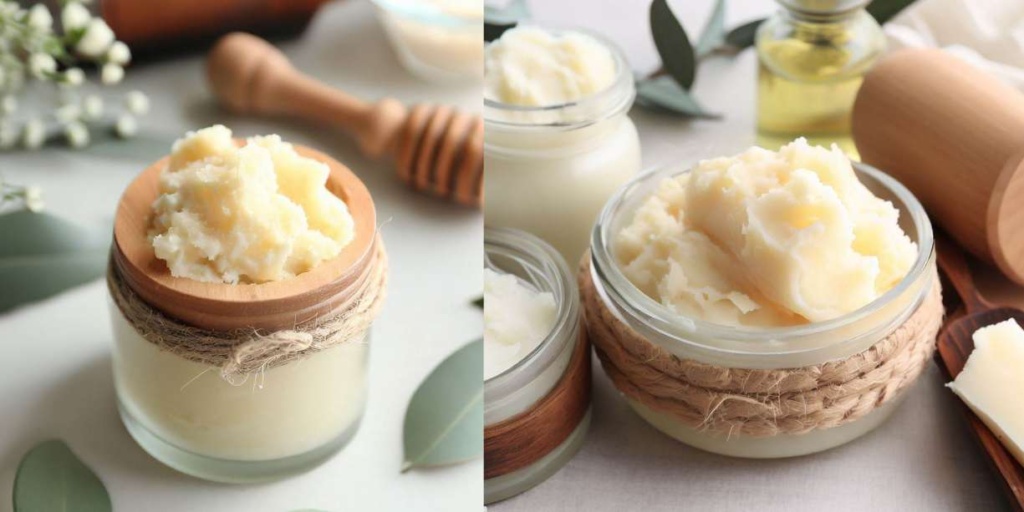
Below you will find the perfect DIY Shea Butter deodorant recipe for you
Ready?
I have lovingly crafted 9 distinctive Shea Butter deodorant recipes to meet your particular needs. Whether you’re a DIY beginner, an expert, or somewhere in between, there will be a recipe for you.
Our collection is thoughtfully designed to cater to various skin types, lifestyles and levels, ensuring a personalised touch to your natural skincare routine.
Shea butter is safe for most skin types, but if you have sensitive skin or allergies, consider a patch test or consult a dermatologist. See our Shea Butter Warnings for more details.
Some of the ingredients you will be working with
- Shea Butter: Moisturises and soothes, with vitamins A and E. Ideal for sensitive skin.
- Arrowroot powder: Absorbs sweat, reduces moisture and smooths application.
- Essential oils: Offer natural scents and antibacterial action against odour.
- Coconut oil: Fights body odour, cools, and moisturises.
- Bentonite clay (optional): Absorbs toxins and keeps you fresh.
- Candelilla wax (optional): Helps solidify stick deodorants.
- Kaolin clay (optional): Gentle clay for sensitive skin.
- Vegetable glycerin (optional): Helps with added moisture.
1. Shea Butter deodorant for total beginners
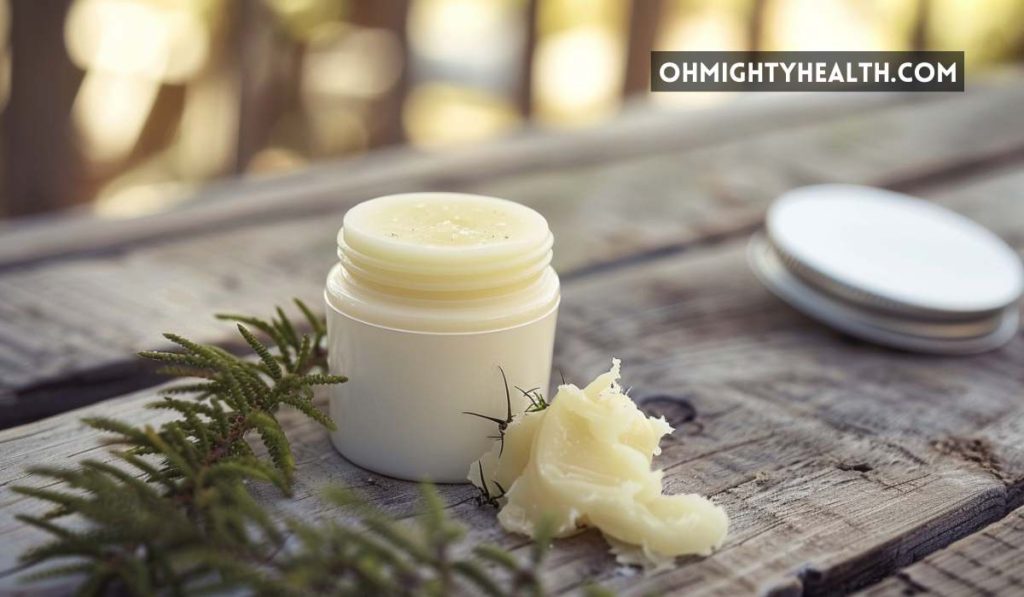
This easy recipe uses just a few ingredients: shea butter to moisturise, arrowroot powder to absorb moisture and neutralise odours, and your favourite essential oil for a nice scent and to fight bacteria. It’s perfect for beginners because it’s simple and straightforward.
Tip: If you’re new to essential oils, lavender is a great start because of its pleasant, universally-liked scent.
Ingredients:
- 1/4 cup Shea Butter: Moisturises, soothes
- 1/4 cup Arrowroot Powder: Absorbs sweat
- 15 drops Essential Oil (like Lavender, Tea Tree, or your preference): Adds fragrance, antibacterial
Steps:
- Melt the shea butter in a double boiler or microwave.
- Mix in the arrowroot powder until thoroughly combined.
- Once cooled but not solidified, add your essential oil and stir well.
- Pour the mixture into a small jar and let it cool.
2. Shea Butter deodorant for DIY enthusiasts
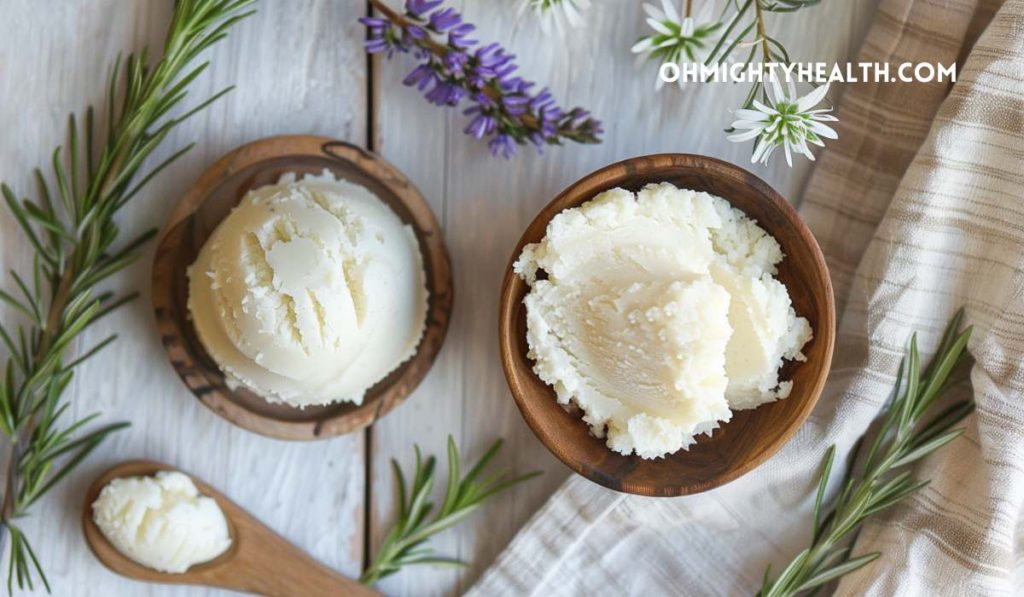
For those comfortable with a few more ingredients, this recipe introduces coconut oil and bentonite clay. Coconut oil enhances the antibacterial action, while bentonite clay helps absorb impurities and toxins.
Hack: Try to mix the powders in gradually to avoid clumping.
Ingredients:
- 3 tbsp Shea Butter: Moisturises, soothes
- 2 tbsp Coconut Oil: Antibacterial, moisturises
- 1/4 cup Arrowroot Powder: Absorbs sweat
- 15 drops Essential Oil (like Lavender, Tea Tree, or your preference): Fragrance, antibacterial
- 1 tbsp Bentonite Clay: Detoxifies, absorbs
Steps:
- Melt shea butter and coconut oil in a double boiler.
- Mix in the arrowroot powder and bentonite clay, ensuring there are no clumps.
- Once the mixture is cooled but not solid, add in the essential oils.
- Pour into an empty jar and let it solidify.
3. Shea Butter deodorant for the more advanced
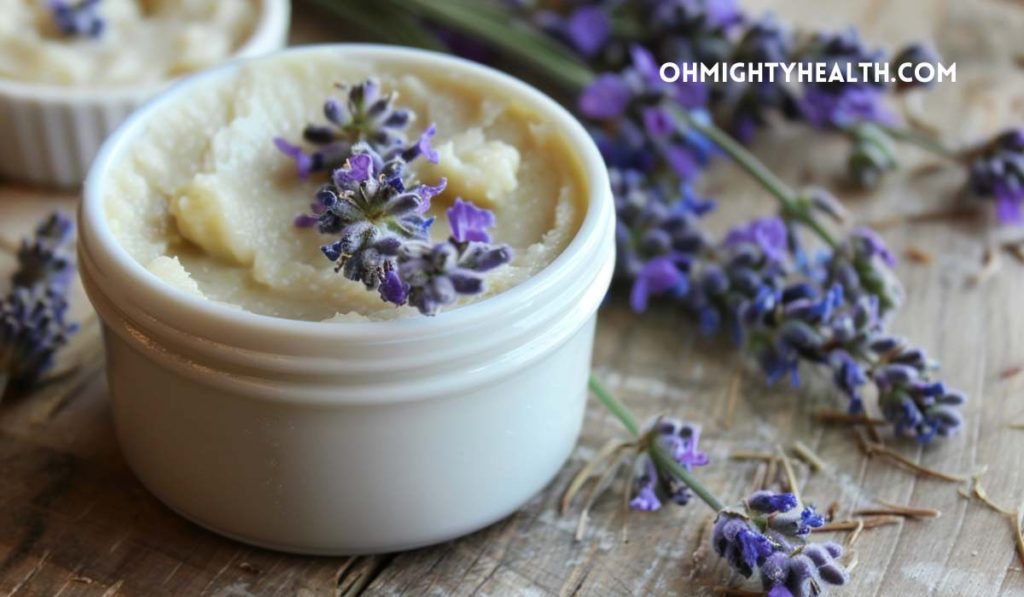
For the adventurous DIYer ready for complex creations, this recipe introduces candelilla wax for a solid stick form, kaolin clay for gentle detoxification, and vegetable glycerin for an extra moisture boost.
Tip: Ensure the mixture is cooled but not solid before adding the glycerin.
Ingredients:
- 1/4 cup Shea Butter: Moisturises, soothes
- 2 tbsp Candelilla Wax: Solidifies, vegan
- 1/4 cup Arrowroot powder: Absorbs sweat
- 1/4 cup Kaolin clay: Gentle detox, suitable for all skin types
- 15 drops Essential oil (like Lavender, Tea Tree, or your preference): Fragrance, antibacterial
- 1 tbsp Vegetable Glycerin: Enhances moisture
Steps:
- Melt shea butter and candelilla wax together in a double boiler.
- Mix in arrowroot powder and kaolin clay until smooth.
- Off the heat, blend in vegetable glycerin and essential oils.
- Pour into a deodorant container or jar and allow to set.
4. Shea Butter deodorant for men
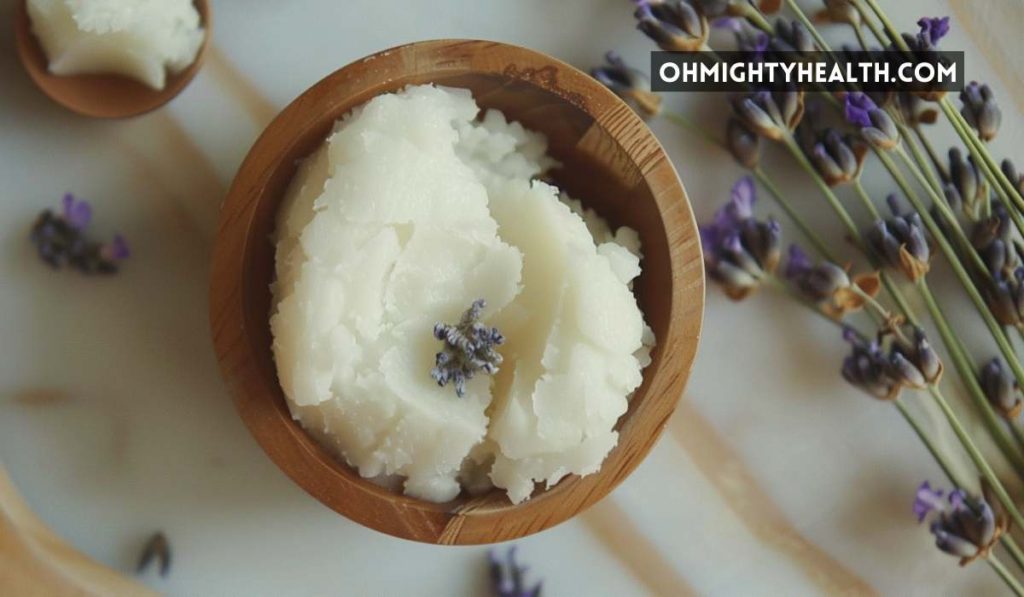
Specifically tailored for men, this recipe incorporates traditionally masculine scents, like sandalwood or cedarwood. The recipe is simple yet effective in combating odours.
Tip: This is a perfect idea for a thoughtful, handmade gift!
Ingredients:
- 3 tbsp Shea Butter: Moisturises, soothes
- 2 tbsp Coconut Oil: Antibacterial, moisturises
- 1/4 cup Arrowroot Powder: Absorbs sweat
- 15 drops Essential Oil (like Sandalwood, Cedarwood, or your preference): Masculine fragrance, antibacterial
Steps:
- Melt shea butter and coconut oil together in a double boiler.
- Stir in the arrowroot powder until smooth.
- After cooling slightly but before solidifying, mix in the essential oils.
- Pour into a deodorant container or jar and allow to set.
5. Two-ingredient Shea Butter deodorant
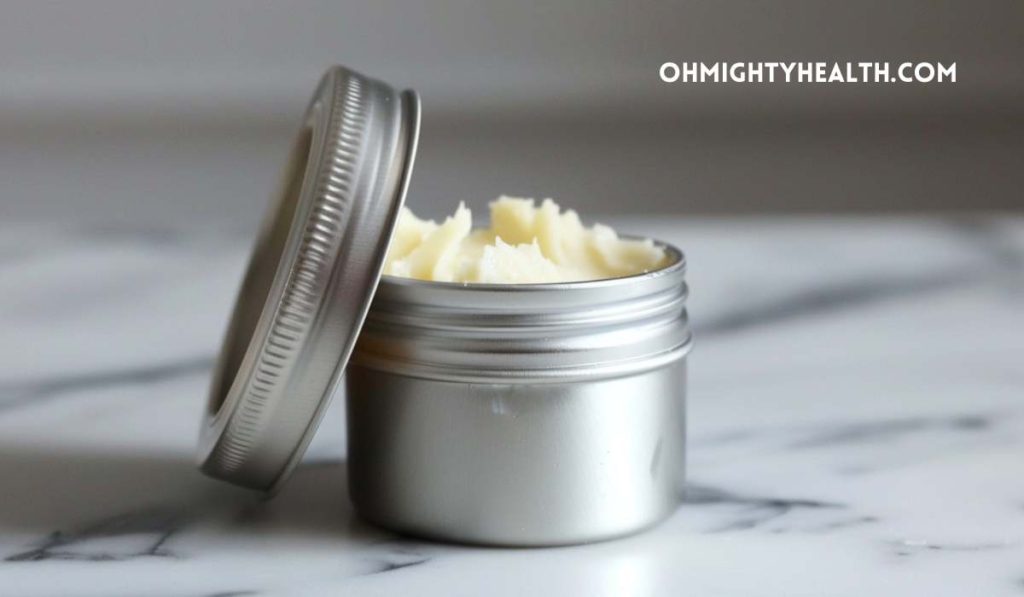
This is the ultimate in simplicity, perfect for those seeking a straightforward, natural deodorant option. With only shea butter and arrowroot powder, you create a gentle yet effective product.
Hack: If you find the mixture too thick, add a bit more melted shea butter.
Ingredients:
- 1/4 cup Shea Butter: Moisturises, soothes
- 1/4 cup Arrowroot Powder: Absorbs sweat
Steps:
- Melt the shea butter using a double boiler or microwave.
- Mix in the arrowroot powder until it’s fully combined.
- Transfer the mixture into a deodorant stick container or small jar and allow it to cool and set.
6. Shea Butter deodorant for those with very sensitive skin
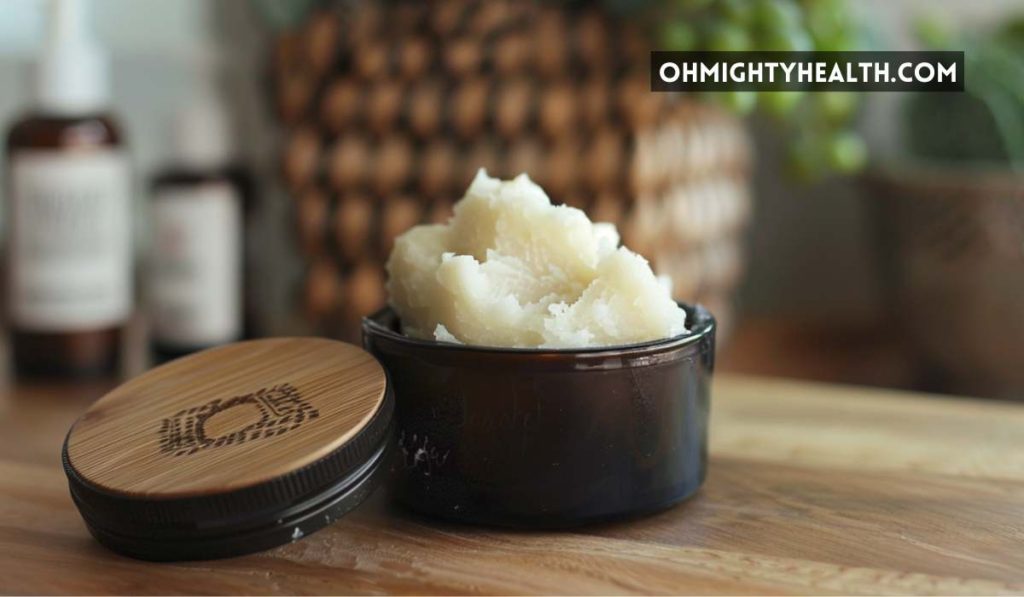
For those with very sensitive skin, this recipe incorporates chamomile essential oil, known for its calming and soothing properties. It’s a gentle yet effective blend for keeping fresh without causing irritation.
Tip: You can use Roman or German chamomile essential oil; both are suitable for sensitive skin.
Ingredients:
- 1/4 cup Shea Butter: Moisturises, soothes
- 1/4 cup Arrowroot Powder: Absorbs sweat
- 10 drops Chamomile Essential Oil: Calms, soothes
Steps:
- Melt the shea butter using a double boiler or microwave.
- Blend in the arrowroot powder until smooth.
- After cooling slightly but before solidifying, incorporate the chamomile essential oil.
- Transfer into a deodorant stick container or small jar and allow to set.
7. Shea Butter deodorant for sports enthusiasts
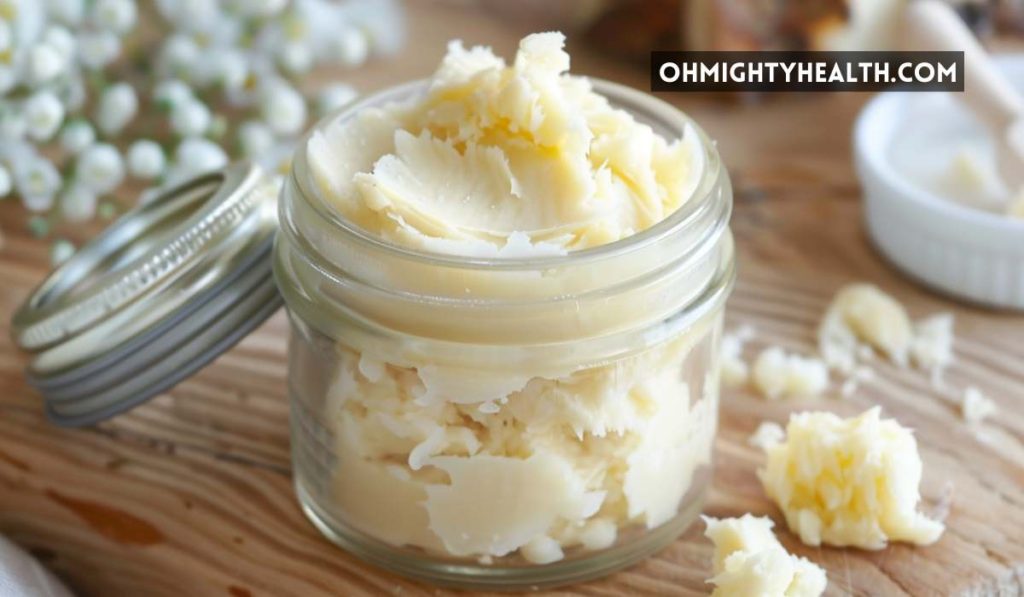
For active individuals, we’ve included eucalyptus essential oil, renowned for its refreshing scent and antimicrobial properties. The added bentonite clay helps absorb excess moisture.
Tip: You can substitute eucalyptus oil with peppermint essential oil for a different cooling effect.
Ingredients:
- 3 tbsp Shea Butter: Moisturises, soothes
- 2 tbsp Coconut Oil: Antibacterial, moisturises
- 1/4 cup Arrowroot Powder: Reduces wetness, absorbs sweat
- 15 drops Eucalyptus Essential Oil: Refreshing, antimicrobial
- 1 tbsp Bentonite Clay: Absorbs moisture
Steps:
- Melt shea butter and coconut oil together in a double boiler.
- Stir in arrowroot powder and bentonite clay until smooth.
- After cooling slightly but before solidifying, mix in the eucalyptus essential oil.
- Pour into a deodorant container or jar and allow to set.
8. Shea Butter deodorant for travellers (solid bar form)
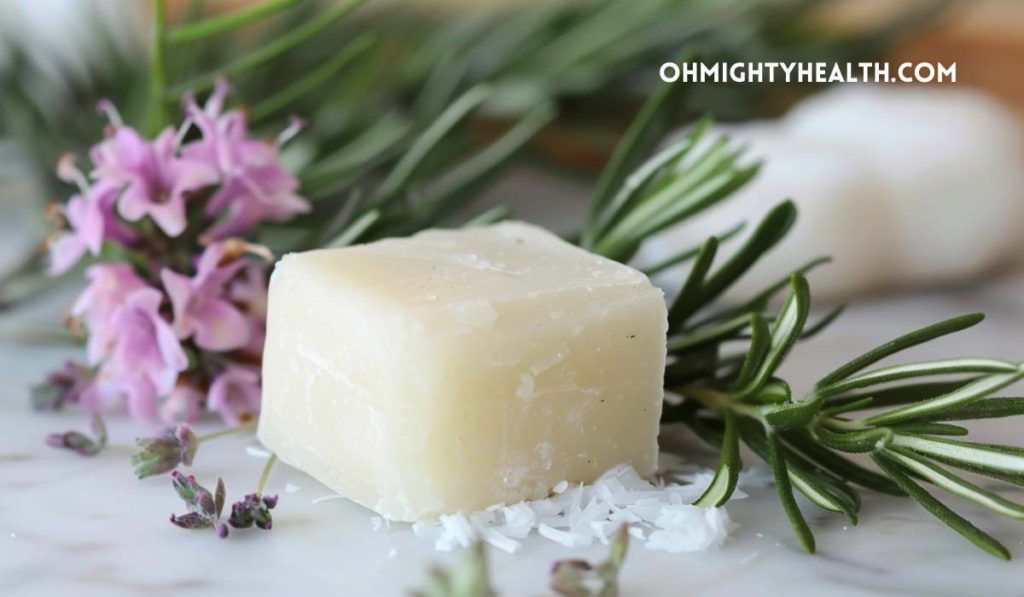
This recipe is perfect for those who are always on the move. The addition of candelilla wax makes this deodorant portable and mess-free.
Hack: Use a small silicone mould to create bite-sized bars perfect for travel.
Ingredients:
- 3 tbsp Shea Butter: Moisturises, soothes
- 2 tbsp Candelilla Wax: Solidifies, travel-friendly
- 1/4 cup Arrowroot Powder: Absorbs sweat
- 15 drops Essential Oil (like Lavender, Tea Tree, or your preference): Fragrance, antibacterial
Steps:
- Melt shea butter and candelilla wax together in a double boiler.
- Stir in arrowroot powder until fully mixed.
- After cooling slightly but before solidifying, add the essential oils and mix well.
- Pour into a silicone mould for solid bar formation and let it cool.
9. Shea Butter deodorant for children
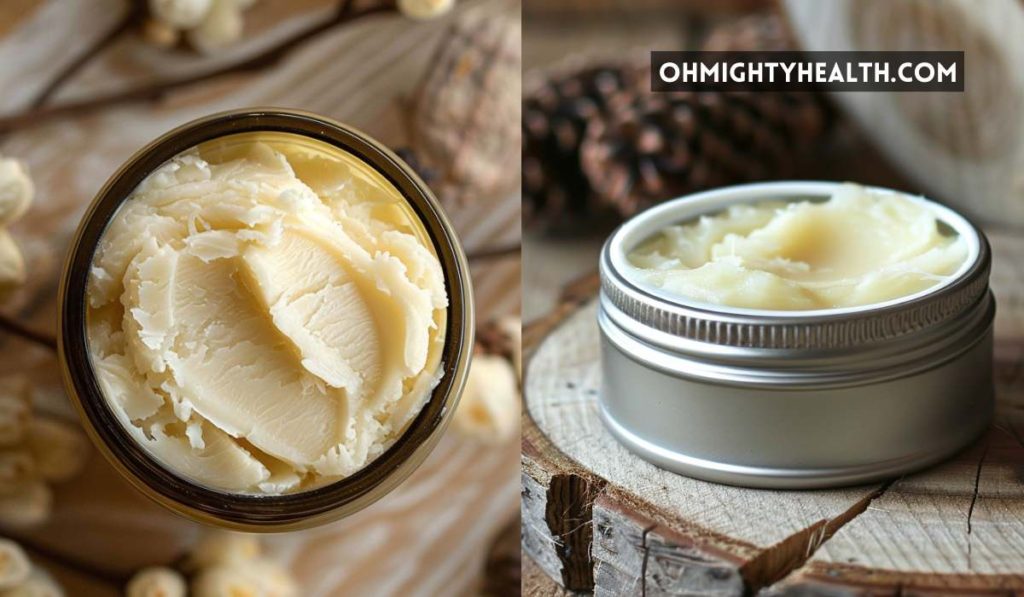
Specially formulated for the delicate skin of children, this recipe is gentle, hydrating, and free from essential oils. Shea butter and coconut oil provide moisture, while arrowroot powder ensures a soft, effective application.
Tip: Always supervise children when applying to ensure they don’t apply too much.
Ingredients:
- 3 tablespoons Shea Butter: Moisturises, soothes
- 1.5 tablespoons Arrowroot Powder: Gentle absorption
- 1.5 tablespoons Coconut Oil: Hydrates, antibacterial
Steps:
- Melt the Shea butter and coconut oil together, either in a double boiler or microwave.
- Stir in the arrowroot powder until well combined.
- Pour the mixture into a deodorant container or small jar and let it cool.
- Once solidified, it’s ready for use, with supervision for children.
Note on Use for Children:
Although children typically don’t require deodorant in the same way adults do, introducing a mild, natural deodorant can be beneficial for several reasons. It can help children develop good hygiene habits early on, especially during activities that might cause sweating, like sports. Additionally, using a gentle deodorant can provide comfort and confidence as they grow and become more aware of their bodies, without exposing them to harsh chemicals often found in commercial products. This DIY deodorant is designed to be safe and gentle for children, offering a soft introduction to personal care.
Essential tools for your DIY deodorant
Creating your own Shea Butter Deodorant is simple and doesn’t require many tools. Here’s what you’ll need:
- Double boiler: A must-have for gently melting your Shea butter and other solid ingredients. If you don’t own one, a heat-safe bowl over a pot of simmering water works just as well.
- Mixing spoon: This will help incorporate all the ingredients smoothly. Opt for a non-metal one if you’re using bentonite clay, as metal can reduce its effectiveness.
- Empty small jars: These will hold your finished product. You can either reuse an old deodorant container or purchase new ones online.
- Measuring spoons: For accurate measurement of ingredients.
Storage and shelf-life of DIY Shea Butter deodorant
Proper storage can significantly increase the lifespan of your homemade deodorant:
- Storage: Keep your deodorant in a cool, dry place. If you live in a particularly warm climate, you may want to store it in your refrigerator to prevent it from melting.
- Shelf-life: Your DIY deodorant should last about three to six months. If you notice any changes in colour, smell, or texture, it’s best to make a fresh batch.
Always perform a patch-test in DIY skincare
Before applying your DIY Shea Butter Deodorant, always perform a patch test by applying a small amount of the product to the inside of your wrist or elbow, then wait for 24 hours.
If any irritation occurs during this time, do not use the product.
In love with Shea Butter yet? Learn to make Shea Butter oil! Perfect for your body if you have dry skin.
The joy of creating something uniquely yours!
I truly hope these recipes spark your curiosity and get you to explore more DIY skincare.
At least to learn about natural ingredients for skin and health and how to incorporate them into your daily routine.
They are the key to a natural lifestyle.
And you (like me) deserve it.
FAQs
As a certified natural skincare formulator I have come across many questions and problems throughout the years.
Here we look at some of them.
(If you have any questions, please leave them in the comment section and I will try to get back ASAP!).
Can I use Shea Butter on its own as a deodorant?
Shea butter alone can work for basic skincare as a deodorant, but it has limitations in odour prevention and moisture control. If you need stronger protection against body odour or sweat, it won’t be enough.
Can I substitute Shea Butter with other types of butter?
Yes, you can use alternatives like cocoa butter or mango butter. However, the texture and properties may differ, so you might need to adjust the other ingredients accordingly.
Why is my DIY deodorant causing skin irritation?
Even natural ingredients can cause irritation for some people. If you experience irritation, stop using the deodorant and perform a patch test with each ingredient to identify the culprit.
How long does DIY Shea Butter Deodorant last?
If stored properly, your DIY deodorant should last between three to six months. If you notice any changes in colour, smell, or texture before then, it’s best to discard it and make a fresh batch.
Why has my deodorant changed in consistency?
The consistency of your deodorant can change due to temperature fluctuations. If it’s too hard, reduce the amount of candelilla wax in your next batch. If it’s too soft, add a little more.
Can I use baking soda in my Shea Butter deodorant recipe?
While baking soda is a common ingredient in DIY deodorants due to its odour-neutralising properties, some people find it irritating. If you choose to use it, ensure to do a patch test first. If you prefer to avoid baking soda, our recipes provide effective alternatives.
Can I add more essential oil to the recipe if I want a stronger scent?
I recommend you stick to the amounts provided above. If you want to add more, please read our article Essential Oil Amounts for DIY Products and also How to Mix Shea Butter with Essential Oils.
What other DIY skincare products can I make with Shea Butter?
Shea Butter is incredibly versatile and can be used to create numerous other skincare products, including lotions, lip balms, body butters, and even hair conditioners. Check out other articles on Shea Butter where you’ll be able to discover wonderful DIY recipes.
Resources
- Yameogo BGJ, Kabore CFW, Sombie BC, Diawara HZ, Wouessidjewe D, Semde R, et al. C34 Formulation of shea butter-based lipid nanoparticles for topical and transdermal applications. Journal Africain de Technologie Pharmaceutique et Biopharmacie (JATPB) [Internet]. 2023 [cited 2024 Feb 28]; 2(3). Available from: https://soapgi-jatpb.org/index.php/jatpb/article/view/127.
- Odusote J, Oni H, Adeleke A, Ikubanni P, Omoniyi P, Jen T-C, et al. Production and Performance Evaluation of Shea Butter-Based Lubricating Grease. E3S Web Conf [Internet]. 2023 [cited 2024 Feb 28]; 430:01297. Available from: https://www.e3s-conferences.org/articles/e3sconf/abs/2023/67/e3sconf_icmpc2023_01297/e3sconf_icmpc2023_01297.html.
- Ayanrinde FA, Oyewole SO, Anyanrinde OA, Oyewole AL. Analysis of Shea Butter (Vitellaria paradoxa) Marketing in Ibarapa Central Local Government Area of Oyo State, Nigeria. Journal of Applied Sciences and Environmental Management [Internet]. 2023 [cited 2024 Feb 28]; 27(9):1985–8. Available from: https://www.ajol.info/index.php/jasem/article/view/256278.
- Lin T-K, Zhong L, Santiago JL. Anti-Inflammatory and Skin Barrier Repair Effects of Topical Application of Some Plant Oils. Int J Mol Sci [Internet]. 2017 [cited 2024 Feb 28]; 19(1):70. Available from: https://www.ncbi.nlm.nih.gov/pmc/articles/PMC5796020/.
